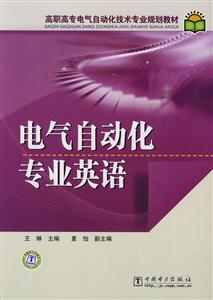电气自动化专业英语
节选
[
《电气自动化专业英语》为高职高专电气自动化技术专业规划教材。全书分为5章,共计26课。**章电工电子技术基础,主要介绍电路元器件、电路网络分析、二极管、运算放大器、逻辑电路等;第二章电机和电机控制,主要介绍直流电动机、交流异步电动机、电动机控制电路、脉宽调制理论、变频器等;第三章工业计算机控制技术,主要介绍PLC、单片机、现场总线等;第四章传感器,主要介绍温度传感器、霍尔传感器、光电传感器及红外线传感器等;第五章自动控制系统,主要介绍自动控制系统简介、传递函数、波德图、过程控制等。《电气自动化专业英语》所有课文均精心选自国外相关网站和教材,具有专业性和实用性强、难度适宜等特点,有助于培养学生阅读电类英文资料的能力。《电气自动化专业英语》可作为高职高专电气自动化等相关专业的教材,也可供中等职业学校相关专业使用及专业英语爱好者学习参考。
]
相关资料
[
插图:Using this rotor flux linkage vector the stator current vector is further transformed into acoordinate system where the real x-axis is aligned with the rotor flux linkage vector.Now the real x-axis component of the stator current vector in this rotor flux orientedcoordinate system can be used to control the rotor flux linkage and the imaginary y-axiscomponent can be used to control the motor torque.Typically PI-controllers are used to control these currents to their reference values.However, bang-bang type current control, that gives better dynamics, is also possible.With PI-controllers the outputs of the controllers are the x-y components of the voltagereference vector for the stator. Usually due to the cross coupling between the x- and y-axes adecoupling term is further added to the controller output in order to improve the controlperformance when big and rapid changes in speed, current and flux linkage take place. Usuallythe PI-controller also needs low-pass filtering of either the input or output of the controllerin order to prevent the current ripple due to transistor switching from being amplifiedexcessively and unstabilizing the control. Unfortunately, the filtering also limits thedynamics of the control System, Thus quite high switching frequency (typically more than 10kHz) is required in order to allow only minimum filtering for high performance drives suchas servo drives.Next the voltage references are first transformed to the stationary coordinate system(usually through rotor d-q coordinates) and then fed into a modulator that using one of themany Pulse Width Modulation (PWM) algorithms defines the required pulse widths of the statorphase voltages and controls the transistors (usually IGBTs) of the inverter according to these.This control method implies the following properties of the control (Fig.2.37):Speed or position measurement or some sort of
]
本书特色
[
《电气自动化专业英语》:高职高专电气自动化技术专业规划教材
]
内容简介
[
本书为高职高专电气自动化技术专业规划教材。
全书分为5章,共计26课。**章电工电子技术基础,主要介绍电路元器件、电路网络分析、二极管、运算放大器、逻辑电路等;第二章电机和电机控制,主要介绍直流电动机、交流异步电动机、电动机控制电路、脉宽调制理论、变频器等;第三章工业计算机控制技术,主要介绍plc、单片机、现场总线等;第四章传感器,主要介绍温度传感器、霍尔传感器、光电传感器及红外线传感器等;第五章自动控制系统,主要介绍自动控制系统简介、传递函数、波德图、过程控制等。本书所有课文均精心选自国外相关网站和教材,具有专业性和实用性强、难度适宜等特点,有助于培养学生阅读电类英文资料的能力。
本书可作为高职高专电气自动化等相关专业的教材,也可供中等职业学校相关专业使用及专业英语爱好者学习参考。
]
目录
**章 电工电子技术基础 第1单元 电气元件与网络 第2单元 网络分析 第3单元 二极管 第4单元 运算放大器 第5单元 数字逻辑门 第6单元 触发器 第二章 电机和电机控制 第7单元 电动机和直流电动机 第8单元 感应电动机 第9单元 简单电动机控制电路 第10单元 直流电动机的脉宽调制理论 第11单元 变频器 第三章 工业计算机控制技术 第12单元 可编程控制器综述 第13单元 plc的应用 第14单元 微控制器/单片机介绍 第15单元 8051指令系统 第16单元 现场总线 第四章 传感器 第17单元 传感器简介 第18单元 温度传感器概述 第19单元 霍尔传感器 第20单元 超声波传感器 第21单元 光电传感器 第五章 自动控制系统 第22单元 控制系统介绍 第23单元 传递函数 第24单元 波德图 第25单元 过程控制系统 第26单元 集散控制系统 附录1 电气专业课程中英文对照 附录2 论文英文摘要的书写 参考文献
封面

书名:电气自动化专业英语
作者:王琳
页数:265
定价:¥27.6
出版社:中国电力出版社
出版日期:2009-12-01
ISBN:9787508393407
PDF电子书大小:83MB 高清扫描完整版
